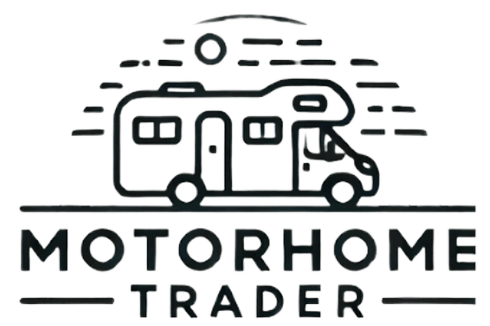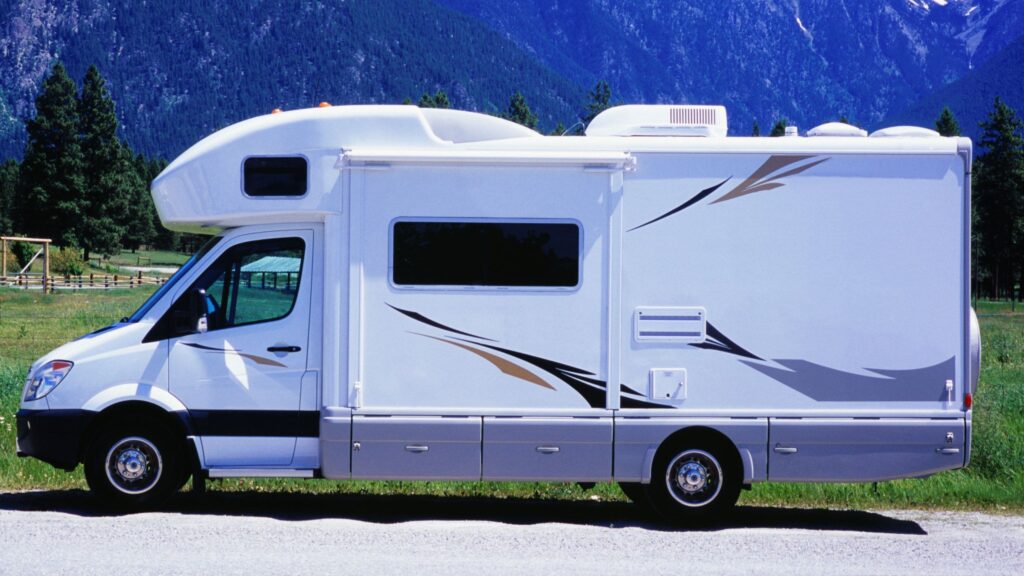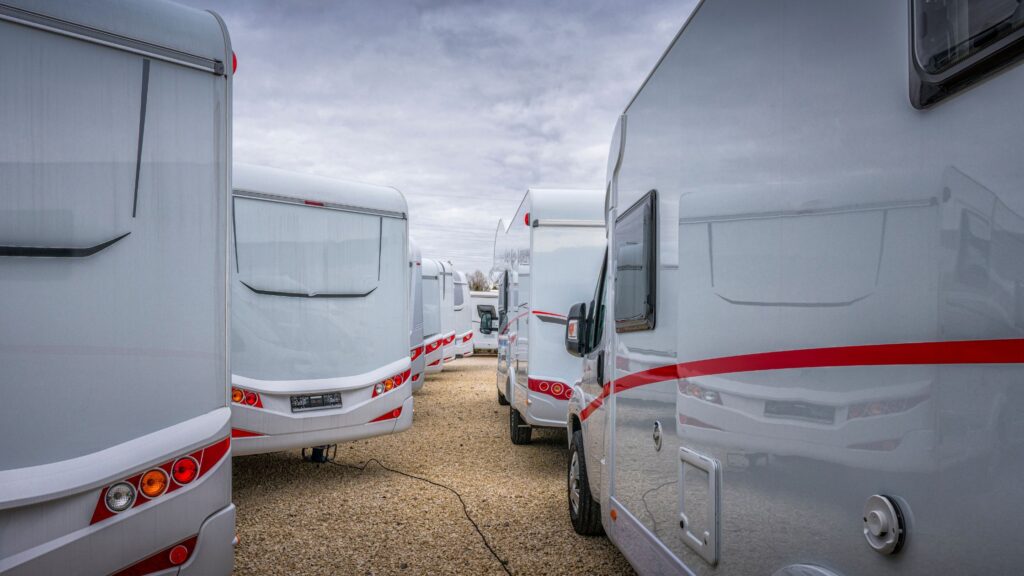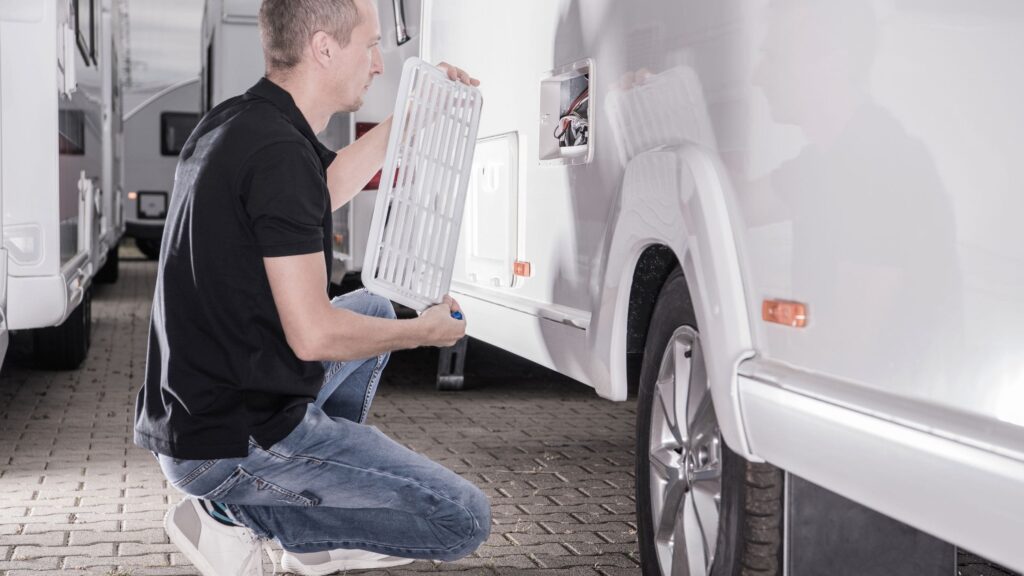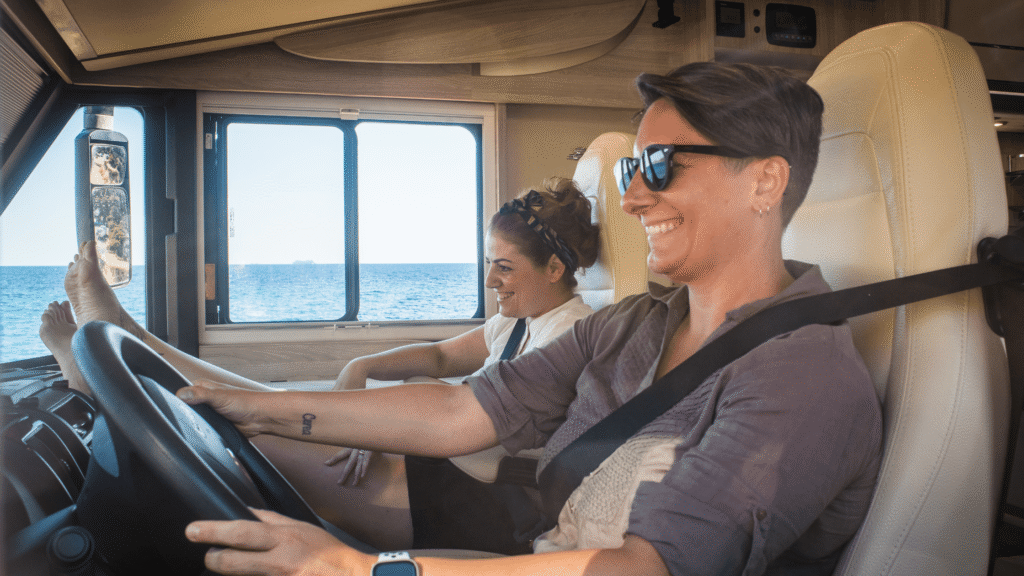If you’ve ever wondered, “How much is my motorhome really worth?”, you’re not the only one. Whether you’re thinking about upgrading, downsizing, or simply curious about today’s motorhome market, knowing the real value of your RV can save you from underpricing, or overestimating. The truth is, a motorhome’s value isn’t just about age or mileage. It’s also about timing, upkeep, condition, paperwork, and how well you understand what today’s buyers are really looking for.
We’ve seen how service records, upgrades, and even seasonal trends can shift the numbers more than you might expect. That’s why getting a proper valuation, whether through a motorhome dealer or broker, a free online tool, or a professional appraisal, can make all the difference.
In this article, we’ll focus on the smart steps you can take to understand, protect, and boost the value of your motorhome, so when it’s time to sell, you’re ready to get the deal you deserve.
Do Motorhomes Hold Their Value?
Compared to a typical car, a motorhome tends to retain its value significantly better over time. On average, motorhomes lose about 10% of their value each year. However, the rate of depreciation is sharpest during the first three years, largely due to initial purchase premiums and rapid mileage accumulation. After this initial drop, depreciation tends to slow, especially if you’ve taken good care of the vehicle.
Key factors that help some motorhomes hold their worth include having low mileage for the age, maintaining thorough service records, and owning a trusted brand model like Hymer, Swift, or Knaus. Buyers in the used motorhome market will always check for documentation that proves ongoing maintenance, which can directly impact the final resale value.
Still, external market data plays a role. For example, the surge in campervan and RV sales during the 2020 staycation boom temporarily pushed secondhand prices higher across the US. In that window, some owners sold at a profit. This proves that your motorhome’s value is shaped by more than just age or condition, it’s also influenced by economic cycles, market demand, and seasonal buyer behavior.
Ultimately, if you want to sell your motorhome and make the most of your investment, you need to understand how depreciation interacts with brand reputation, condition, and market timing. Getting a valuation estimate from a trusted company or website, particularly those offering a free motorhome valuation without obligation, is a smart first step.
What Factors Affect a Motorhome’s Value?
Age and mileage are among the most influential factors that affect a motorhome’s value. In general, for motorhomes under ten years old, every additional 10,000 miles can reduce resale value by 3 to 5 percent. High mileage relative to age often signals wear, particularly on the chassis and drivetrain, even if the interior looks clean.
Condition plays a crucial role. This includes both the mechanical integrity and cosmetic state of the vehicle. Issues like faded paintwork, cracked seals, or upholstery damage from sun exposure can lower offers. Vehicles stored indoors or under all-weather covers typically show less wear and retain more value over time. Dampness and sun damage are especially detrimental to long-term durability.
A full service history adds substantial credibility and often raises valuation by 5 to 10 percent. Paperwork documenting routine maintenance, habitation checks, and past upgrades builds confidence with prospective buyers. On the other hand, missing or disorganized records can deter serious interest, even if the vehicle appears well maintained.
The manufacturer and model also matter. Brands with strong reputations for quality, especially those known for comfort, fuel efficiency, or layout innovation, tend to depreciate more slowly. Interior features such as fixed beds, premium fittings, and efficient layouts appeal to a wider audience and strengthen resale prospects.
Demand varies by season and geography. Listings in high-tourism regions or close to national parks typically generate more inquiries. If you advertise in such locations, you’re more likely to receive higher offers. Economic conditions also matter. In times of growth, demand rises, and resale prices follow. In downturns, the opposite occurs.
Upgrades can add or subtract value depending on type and execution. Security features like alarms or trackers generally improve appeal. However, modifications that reflect personal taste, like bold color schemes or unconventional flooring, can turn off buyers, limiting your reach in the market.
Storage history, usage patterns, and where you choose to list the vehicle all impact how much your motorhome is worth. Taking the time to gather your documents, review recent market trends, and use a free valuation tool before listing will give you a realistic expectation and a better negotiating position.
How Does Depreciation Impact Motorhome Value?
Depreciation describes the loss of value over time. For motorhomes, this decline follows a predictable curve that starts steep and gradually flattens. On average, expect a drop of 20 to 30 percent within the first three years of ownership. After that, annual depreciation typically slows to around 10 percent, then settles closer to 5 to 7 percent after five years.
The initial decrease happens quickly due to several factors. New vehicles command a premium that disappears the moment they’re registered. Warranty periods often end by year three, reducing appeal to cautious buyers. Plus, frequent updates in technology—such as energy-efficient appliances, upgraded power systems, or digital entertainment units—can make even fairly new motorhomes seem dated.
Consider this simplified example: if you purchase a motorhome for $90,000, it may be worth about $72,000 after year one and around $58,000 by year three. These figures fluctuate based on mileage, condition, documentation, and optional extras.
Not all motorhomes follow this depreciation path. Well-maintained specialty models, rare editions, or units with limited production runs can hold their value better—especially if they include desirable features and remain in excellent condition. In some cases, these may even increase in value due to scarcity.
Broader economic forces also impact depreciation. During a financial contraction, discretionary spending falls, and fewer buyers enter the market. This drives prices down. Conversely, when supply is constrained, like during global production slowdowns or spikes in outdoor travel interest, values can stabilize or even increase temporarily.
Depreciation isn’t just a theoretical concept, it directly affects when to sell, how to insure, and what price you can expect.
How to Slow Depreciation and Preserve Motorhome Value
You can’t stop depreciation, but you can absolutely slow it down. If you want to protect the value of your motorhome over time, consistent care, smart storage, and documented upgrades are essential. These steps not only preserve the condition of the vehicle but also provide concrete proof of care, something buyers value during resale or part exchange.
Start by scheduling regular engine servicing and habitation checks. Keep all service invoices stamped and organized. This habit forms the backbone of your service history and may boost resale value by 5 to 10 percent. It also reinforces trust with prospective buyers browsing listings or filling out an online valuation form.
Storage conditions matter more than most people realize. If you can store the vehicle under a roof or use a breathable all-weather cover, you’ll reduce UV damage to seals, tires, and paint. Window shades and tire protectors also prevent long-term wear.
Clean your motorhome inside and out after every trip. Removing road salt promptly helps prevent corrosion in hard-to-see areas like the chassis and underbody. Take the same approach to minor repairs—address issues like bulb replacements, seal cracks, or chipped paint as soon as you notice them. Left untreated, these small problems grow into value-draining repairs.
Upgrades are another opportunity to protect long-term value. Prioritize additions with broad appeal such as solar panels or reversing cameras, which often recover 40 to 60 percent of their cost at resale. On the other hand, custom interiors or bold cosmetic changes may not appeal to the average buyer, reducing interest and narrowing your audience.
Every upgrade, service, or repair should be documented. Keep dated receipts, photos, and any manuals organized by year. If you ever decide to sell your motorhome, having that full record ready gives you an advantage, especially if you’re requesting a free motorhome valuation or consulting professional appraisal services.
Finally, timing matters. Try to list your vehicle for sale in late winter or early spring, when demand spikes ahead of peak travel season. During this window, values can rise by 5 to 10 percent, making it one of the most effective ways to capture more from your sale without additional investment.
How Does Mileage and Condition Influence Valuation?
Vehicles with lower-than-average mileage for their age hold more value and attract more attention. As a general rule, every additional 10,000 miles on a motorhome under ten years old can reduce its value by 3 to 5 percent. While that might seem like a small amount, it adds up quickly across higher mileages or models with less robust service records.
Condition, however, can offset moderate mileage if it reflects consistent care. When buyers inspect a used motorhome, they usually check body panels for dents or signs of past accidents, test roof seals, and request damp meter readings. Interior features and appliances also play a role. A fridge that doesn’t cool properly or worn-out upholstery may raise concerns about overall upkeep.
One of the most critical issues is water ingress. Signs of untreated damp can reduce resale value by 15 to 20 percent or make a unit unsellable, especially in a competitive market. That’s why periodic damp inspections—and acting on any findings—are so important. It also helps to keep images from past reports to show any previous issues were properly addressed.
Mechanical integrity matters just as much. A clean MOT history is a sign of a well-maintained vehicle and often justifies a stronger asking price, especially if you’re trying to sell quickly. It also signals that the core systems—engine, brakes, suspension—have been tested and verified.
Keeping your motorhome in strong cosmetic and mechanical condition, combined with below-average mileage, significantly boosts resale outcomes. It also improves the accuracy of any digital valuation tool or dealer offer, reducing the chances of adjustment after inspection.
How Maintenance History Influences Value
If you want to strengthen the resale value of your motorhome, maintaining a complete and verifiable service history is essential. A well-documented record of upkeep often adds 5 to 10 percent to a motorhome’s valuation compared to similar models with incomplete or missing documentation.
Buyers rely on paperwork to understand not just how often services were done, but also the type and scope of each one. The most important documents include records of engine servicing, habitation checks covering gas, water, and electrical systems, damp inspection reports, warranty repairs, and receipts for any significant upgrades. This level of detail helps demonstrate consistent care over time.
To make a good impression during viewings or appraisals, you should store your paperwork in clear sleeves, sorted by year. This allows prospective buyers, dealers, or appraisal teams to quickly verify information. If you’re completing an online valuation form or inquiring about a free motorhome valuation, this documentation supports more accurate pricing and builds trust from the outset.
How Motorhome Storage Conditions Affect Value
Storage conditions directly affect the wear and tear that builds up over time, making this one of the most underestimated factors in a motorhome’s overall value. Vehicles stored indoors or under cover experience less UV exposure, slower seal degradation, and minimal tire aging. These conditions help preserve exterior finishes and key structural elements. Buyers tend to notice when a vehicle has been well stored, and visible proof, such as photos or rent receipts, can reinforce higher asking prices.
By contrast, motorhomes left outside year-round without protection often show clear signs of weather damage. Faded decals, patchy paintwork, and cracked window seals raise red flags during inspections. Prolonged exposure also encourages algae buildup around roof lights and corners, areas many buyers check first. These signs suggest neglect, even if the rest of the motorhome is mechanically sound.
If you plan to sell your motorhome in the future or get an accurate valuation, storage history matters. Documenting how and where you store the vehicle, including photos or dates, adds credibility to your maintenance record and supports a higher resale value.
How Do Upgrades and Additions Affect Your Motorhome’s Worth?
Upgrades can significantly influence how much your motorhome is worth, but only when those improvements align with buyer expectations. Practical and widely appealing additions tend to deliver better returns. For example, features like solar panels, reversing cameras, and satellite systems typically recoup 40 to 60 percent of their installation cost during resale.
Security upgrades, including GPS trackers and motion-detecting alarms, can boost perceived value by an additional 1 to 3 percent. These enhancements not only appeal to safety-conscious buyers but may also help lower future insurance premiums, making your listing more attractive.
However, not all additions add value. Upgrades that reflect highly personal taste, such as dramatic interior customizations or rare entertainment systems, often narrow your buyer pool. In these cases, potential buyers may factor in the cost of reverting to a more neutral layout, reducing their offer.
The key is to focus on upgrades that improve comfort, usability, or safety without making the motorhome overly unique. When in doubt, consult a valuation expert or review recent market data to understand what features matter most in your model category.
How Different Types of Motorhomes Affect Valuation
Larger models like Class A motorhomes often depreciate more in absolute dollar terms because they carry higher purchase prices from the outset. While they offer generous space and integrated features, the resale market for these vehicles can be limited, which contributes to faster financial decline.
Compact campervans and Class B models tend to experience softer depreciation rates. Their smaller footprint, fuel efficiency, and versatility make them appealing in both urban and rural markets. This consistent demand often results in higher resale value per mile compared to larger RV categories.
Class C units strike a middle ground, offering a balance of size and drivability. Meanwhile, fifth wheels and travel trailers generally hold their value better than motorized models. Since they don’t accumulate mileage on their chassis, they show less mechanical wear and can remain structurally sound for longer.
Layout also matters. A fixed rear bed or open-plan interior usually performs better in the resale market than more complex, convertible seating arrangements. Buyers are increasingly focused on practicality, comfort, and efficient use of space when browsing motorhome models.
How Regional Differences Impact Motorhome Value
Where you live, and more importantly, where you plan to sell, has a measurable effect on how much your motorhome is worth. In high-tourism regions and coastal areas, there’s generally more demand. These locations draw both local buyers and traveling customers, which helps sustain stronger asking prices throughout the year.
In contrast, sparsely populated or rural areas often experience lower market activity. Fewer inquiries and limited dealer presence mean sellers may need to lower their expectations to attract offers. If you’re listing in a quieter region, it can be worthwhile to advertise nationally or work with companies that offer broader valuation tools across state lines.
Climate also plays a role. Motorhomes with strong heating systems, insulated water tanks, and energy-efficient air systems are often worth more in colder climates where all-season usability is essential. Similarly, features like solar panels or awnings gain appeal in sunny regions.
Finally, economic conditions in your area, such as employment rates and housing affordability, shape discretionary spending. These indicators directly influence how aggressively buyers negotiate, how quickly listings move, and whether you’re likely to receive full asking price. If you’re unsure how your region stacks up, reviewing recent sales data and demand trends on reputable RV marketplaces can provide clarity.
How Seasonal Demand Influences Motorhome Value
Historically, prices peak between late winter and early summer as buyers begin preparing for the upcoming travel season. If you list just before this period, your vehicle may attract more attention and achieve a 5 to 10 percent higher return than during slower months.
Autumn and winter typically see a dip in buyer activity. Fewer inquiries, reduced discretionary spending, and an overall drop in travel planning can lower resale momentum. If you need to sell during this time, you might be pressured to reduce your price or accept offers below market averages.
That said, the off-season can be a strategic window for upgrades. By handling improvements like interior refinishing, mechanical servicing, or cosmetic repairs ahead of spring, you put yourself in a stronger position when demand rises. Professional photos taken during bright days, even if off-season, can also help your listing stand out once the motorhome market becomes more competitive again.
When Should You Get Your Motorhome Valued?
One of the most common triggers is preparing to sell your motorhome. Whether you’re listing privately or through a dealer, knowing the current market value gives you confidence in setting a fair and competitive price.
You should also request a motorhome valuation after installing major upgrades, especially if you’ve added features like solar panels, air conditioning, or a new heating system. These improvements may increase the overall value of your motorhome and should be reflected in your insurance cover or resale expectations.
Another important moment is following an accident or repair, when you need to reassess the vehicle’s condition and financial standing. As a rule of thumb, it’s also smart to revalue every two to three years for insurance renewal, or immediately after market shifts, regulatory updates, or economic changes that may influence replacement costs.
How to Value a Motorhome?
There’s no single method that answers how much your motorhome is worth. Instead, accurate valuation depends on gathering and comparing multiple data points, current market listings, recent sales, geographic factors, and the condition of your vehicle.
To get started, review similar motorhome models on trusted platforms and marketplaces. Compare vehicles that match your chassis, layout, mileage, and features. If you’ve made upgrades or modifications, note how these align with other listings and what impact they have on price.
Valuation tools offer another layer of insight. Some online platforms allow you to input your registration number, mileage, and service history to generate a quick estimate. These tools can be helpful for ballpark figures, but the results are often based on averages and don’t always reflect your vehicle’s specific condition or location.
In more complex cases, such as high-value units or those with rare configurations, consulting a professional appraiser may be worthwhile. These specialists review paperwork, inspect the motorhome in person, and produce a detailed report that can support insurance claims or help you set a firm asking price.
How to Research Your Motorhome’s Market Value?
Research is the first step in building an informed valuation. You can start by searching listings for similar vehicles that match your motorhome’s model, year, and configuration. Pay close attention to listed mileage, layout, and installed features when making comparisons. Units with a fixed rear bed or newer kitchen fittings may command more than older, less optimized layouts.
It’s important to check at least three comparable listings, ideally across different platforms. This allows you to see pricing ranges and identify outliers. Remember that advertised prices aren’t always the final sale price, so look for completed sales data when possible.
You should also account for regional differences. A vehicle listed in a high-demand area may sell faster and for more than the same model in a quieter market. Adjust your estimate accordingly. By combining listing data with recent sales figures and mileage-based depreciation benchmarks, you’ll build a more accurate sense of what your motorhome is worth right now.
Using Online Motorhome Valuation Tools
Online valuation tools are a convenient starting point when you’re trying to estimate the value of your motorhome. These platforms typically request key inputs such as your registration number, year, mileage, condition details, and any notable upgrades like solar panels or air conditioning. Once submitted, they generate an instant price estimate based on current market data.
These tools are helpful for quick checks, especially if you’re just beginning to think about selling or updating your insurance cover. However, the figures provided are usually averages and may not fully reflect rare features, custom layouts, or exceptional service records. Some tools may even undervalue high-spec models simply because they fall outside typical data parameters.
If you want a free motorhome valuation, look for companies that let you preview the estimate without any obligation or pushy follow-up. Just be aware that for more precise results, combining digital tools with current listings and professional insight offers a clearer picture of what your motorhome is really worth.
Analyzing Recent Sales and Listings
While online valuation tools offer a general range, you’ll need to dive deeper into recent sales and current listings to understand real-world market behavior. Start by browsing specialist platforms and filter for completed sales rather than just advertised prices. This gives you a more accurate idea of what buyers are actually paying, not just what sellers hope to get.
Adjust for key variables such as mileage, age, features, and layout. If your motorhome has significantly lower mileage or includes valuable extras, you may be able to justify a higher asking price. Conversely, if your unit has more wear or lacks documentation, expect to adjust downward.
When reviewing auction results, don’t forget to account for fees. These commissions often range from 5 to 10 percent, which can distort final sale values if you’re comparing directly with private listings. By interpreting these numbers properly, you gain a clearer sense of where your motorhome fits into the broader resale landscape.
Consulting Professional Appraisal Services
For a more tailored and accurate valuation, especially on high-value units or those with unique configurations, consider hiring a certified appraiser. These professionals evaluate your motorhome in person, review service history and paperwork, and assess condition inside and out. Their experience with various motorhome models and market conditions often leads to more precise pricing than automated tools.
An appraisal can be particularly valuable when selling privately, settling insurance claims, or preparing for a part exchange. While there’s usually a fee involved, this cost is often offset by avoiding underpricing or helping you justify your asking price to skeptical buyers.
Professional valuation services may also provide formal documentation that can be submitted with your sale listing or insurance policy. This adds credibility to your offer and can reassure buyers that the price is fair, backed by real data, not just guesswork from a website or online form.
How to Prepare Your Motorhome for Valuation?
Start by addressing any minor mechanical issues or cosmetic defects. Fixing things like cracked light lenses, slow-draining sinks, or loose fittings can help eliminate buyer objections and avoid value reductions during an official inspection. Small improvements often result in a better perceived condition, which directly impacts your resale value.
You’ll also want to gather your documentation. Service history, MOT records, and upgrade receipts should be collected in an organized folder. When you show that everything from engine servicing to damp checks has been done regularly, it creates confidence in the long-term care and worth of your motorhome.
Once your paperwork is ready and the condition is polished, you’re in the best position to get a realistic and favorable valuation, whether through a free motorhome valuation tool or a certified appraisal.
Cleaning and Presentation Tips
Cleanliness has a direct impact on how much your motorhome is worth. A spotless interior and well-maintained exterior can instantly increase buyer interest and influence how appraisers interpret condition during the valuation process.
Start with the basics: vacuum all carpeted areas, wipe down upholstery, and remove any lingering odors. Pay close attention to the bathroom and kitchen areas, where buildup can form around fixtures and cause a negative impression. If needed, steam-clean surfaces or replace minor fittings to freshen the look.
Outside, wash the vehicle thoroughly, including the roof and wheel arches. Polishing the paintwork, dressing the tires, and restoring trim color can all enhance visual appeal. Remove decals if they’re faded or peeling, as this signals neglect. Take care to clean windows, roof lights, and awnings too, they’re common inspection points during both appraisals and private viewings.
Repairing Minor Mechanical and Cosmetic Issues
Before you request a motorhome valuation or complete a valuation form, it’s important to address small issues that could reduce your motorhome’s perceived value. While they might seem insignificant, minor defects can suggest neglect, prompting buyers or appraisers to lower the price.
Common quick fixes include repairing chipped paint, polishing light scratches, and replacing cracked lenses or worn wiper blades. Check for dripping taps, loose fittings, and oil leaks under the chassis, these are simple to resolve but can raise red flags during inspections. Ensure all appliances, including air conditioning and gas systems, are functional and clean.
If your vehicle has any dashboard warning lights on, investigate and resolve the underlying issue before any viewing or appraisal. Investing a little time and money into these repairs can significantly impact how much your motorhome is worth, and helps you present it as a well-maintained, reliable vehicle in a competitive motorhome market.
Organizing Important Documentation
Your motorhome’s paperwork plays a vital role in maximizing its valuation. Buyers and professional appraisers alike want to see evidence that your vehicle has been properly cared for. Keeping your service records, receipts, and manuals organized signals transparency and trustworthiness.
Start by collecting key documents: engine service reports, MOT history, habitation checks for water, gas, and electrics, and receipts for upgrades like solar panels or new air conditioning units. If you’ve completed repairs, include proof of work. Manuals for fitted appliances and accessories should also be readily available.
Arrange these records in chronological order, using clear plastic sleeves in a binder. Label each section by year or system for easy access. This level of preparation not only boosts confidence in your asking price but also streamlines the selling process.
What are Common Mistakes When Valuing a Motorhome?
When you’re trying to determine the true value of your motorhome, it’s easy to make errors that lead to unrealistic expectations or missed opportunities. One common mistake is relying too heavily on optimistic asking prices rather than actual sale data. It’s tempting to search listings online and assume your vehicle matches the top figures, but without completed sales for comparison, those numbers may not reflect real market conditions.
Another misstep is ignoring mileage adjustment benchmarks. Every extra 10,000 miles, especially under ten years of age, can reduce the value by 3–5%. If you skip this calculation, your motorhome valuation may be inflated.
Sellers also tend to overlook the impact of damp repairs. Serious moisture problems can reduce your motorhome’s worth by 15–20%, especially if left unresolved. Failing to adjust for seasonal price fluctuations, like softer autumn demand, can skew expectations even further.
Neglecting presentation, such as cluttered interiors or poor-quality photos, lowers appeal. And if your model has specialist customizations or upgrades, skipping expert appraisal services can lead to underestimating or overpricing its true value.
How to Set a Realistic Asking Price for Your Motorhome?
Setting a realistic price is one of the most important steps when you decide to sell your motorhome. The goal is to find a balance between your personal expectations and what the motorhome market will realistically support. Many sellers overestimate what their motorhome is worth based on emotional attachment or the initial purchase cost. Instead, your focus should be on recent market data, service history, condition, and comparable listings.
A good strategy is to list your RV slightly above your target number—typically by 2 to 4 percent. This gives you negotiation space without scaring away potential buyers. At the same time, you avoid underselling and missing out on your motorhome’s actual value. Keep in mind that current market trends, regional demand, layout popularity, and even motorhome depreciation rates will influence the final outcome.
How Insurance Coverage Can Affect Motorhome Valuation
Insurance plays a more significant role in motorhome valuation than many people realize. If your insurance cover is outdated or set too low, your payout in the event of total loss may not reflect the current value of your motorhome. That’s why maintaining an agreed-value policy, supported by regular professional valuations, is essential, especially if you’ve made upgrades or your model has increased in demand.
Review your policy every two to three years or after any major repairs or customizations. For example, adding solar panels, security systems, or air con can affect both resale value and insurance terms. Insurance companies often require detailed documentation, such as service records and valuation forms, which also come in handy when it’s time to sell your motorhome.
Why Do Some Companies Offer Free Motorhome Valuations?
Many companies advertise a free motorhome valuation as a way to attract your attention and gain access to your contact details. These offers serve as powerful marketing tools, helping companies build a pipeline of potential sellers while collecting valuable market data. In exchange, you often receive a quick estimate of what your motorhome is worth based on limited information like model, age, mileage, and condition.
But while these services can be useful, not every free motorhome offer is designed with your best interests in mind. Some companies may provide lowball quotes to secure undervalued stock for resale. To protect your financial outcome, it’s important to compare at least three valuations. Use tools from trusted sources and always follow up with your own market research. Remember, a professional team that asks for detailed service history and clear vehicle data is more likely to deliver a realistic and helpful estimate.
Where to Get a Free Motorhome Valuation?
When you’re ready to assess the value of your motorhome, there are several reliable sources offering free motorhome valuations. Reputable dealers often include this service as part of their sales process, especially if you’re considering a part exchange. Online platforms are another good starting point. Many allow you to input your motorhome’s registration number, service records, and key upgrades to receive a tailored quote within minutes.
RV shows and local appraisal events can also provide on-the-spot assessments from industry experts. These are ideal if you want to meet someone face-to-face and get quick advice on pricing strategy. Just be cautious—some quotes may be designed to tempt you into an immediate sale. Always read the fine print and avoid offers that come with an obligation to list or sell right away. A good valuation should feel like information, not pressure.
What are the Alternative Methods to Value a Motorhome?
Beyond the typical online tools and dealer assessments, there are other ways to determine the true value of your motorhome. Trade-in quotes at multi-brand dealerships can be insightful, especially if you plan to upgrade or switch models. While these valuations often come in slightly lower, they remove the hassle of advertising, negotiations, and direct payments.
Peer marketplaces are another growing option. Sites that let you post your own RV or campervan let you see how similar vehicles perform on the open market. These platforms often reflect real buyer behavior and allow you to adjust your expectations based on actual interest. Just keep in mind that selling privately takes more time and effort, from managing viewings to handling documents like the valuation form, MOT, and insurance cover.
What are the Best Ways to Sell Your Motorhome?
When you’re ready to sell your motorhome, you have several routes available, each with its own trade-offs. The main options include private sale, dealer buy-in, trade-in for another vehicle, public auction, and consignment. Each method comes with different levels of control, effort, and final resale value. Your decision should reflect your timeline, financial expectations, and willingness to handle viewings, paperwork, and buyer questions.
Private sales can yield the best price but require more personal time and marketing. Selling to a dealer is quicker and easier but might fetch less. Auctions and consignment services offer a middle ground, less work for you, but at a fee. No matter which route you take, always start with a current motorhome valuation. Use that as a reference point to compare offers and ensure you’re not leaving money on the table. Accurate paperwork and a well-documented service history will support a stronger asking price.
Selling Privately vs. Selling to a Dealer
If you want maximum control over the process and price, selling your motorhome privately might be your best bet. You set the asking price, negotiate directly with buyers, and keep 100% of the sale. However, you’ll need to manage advertising, viewings, phone calls, and possibly even financing conversations. High-quality photos, a strong description, and a clean interior go a long way in this route.
By contrast, selling to a dealer is fast and stress-free. Many dealers offer same-day payments and may even offer a free motorhome valuation through their website or team. The trade-off is typically a lower offer than you’d get on the open market, as dealers account for resale prep, motorhome depreciation, and potential warranty obligations. For those asking, “How much is my motorhome worth?”, dealers often provide instant quotes based on mileage, condition, and registration number.
Using Auctions or Consignment Sales
Auctions and consignment sales bridge the gap between selling privately and handing your motorhome over to a dealer. In an auction setting, your RV is listed alongside others, and bidding determines the final sale price. This method can work well if you’re targeting an audience of serious buyers, but be aware of commission fees—usually around 5% to 10%. Also, you’ll need to factor in any deductions based on condition or incomplete service records.
Consignment services let a dealer or broker sell your motorhome on your behalf, usually over several weeks. They handle advertising, inquiries, and viewings. In return, they charge a higher fee, typically between 10% and 15% of the final price. This option is best if you want the benefits of a private sale without the day-to-day management. As always, request a signed agreement, and check if the service includes valuation form assistance or insurance cover during the sale process.
What are Legal Considerations When Selling a Motorhome?
Before you sell your motorhome, it’s critical to get the legal paperwork right. This protects both you and the buyer and ensures a clean, enforceable transaction. At a minimum, you’ll need a signed bill of sale that includes the buyer’s full details, vehicle registration number, and agreed price. A proper sales contract helps define the terms and avoids future misunderstandings.
You should also complete the title transfer immediately and notify your DMV or relevant state agency. This formally removes your name from the ownership record and limits future liability. If you’re handling the sale privately, make a copy of the buyer’s ID and keep written proof of payment. In some states, removing or transferring the insurance cover on the day of sale is an added step.
How to Negotiate and Close the Sale Successfully
Once you’ve listed your motorhome and started getting interest, the next step is managing the negotiation process. The key is to remain flexible without compromising too much on value. Begin slightly above your target price to leave room for a 2–4% negotiation margin. Know your minimum acceptable figure in advance, based on current motorhome market data and depreciation factors like mileage or cosmetic wear.
Answer buyer questions promptly and confidently. Transparency about the vehicle’s features, recent upgrades, or service records helps establish trust. You should always confirm serious offers in writing and request a deposit to reserve the sale while final details are confirmed.
Before handing over the keys, ensure all paperwork is signed, including the title, sale agreement, and any warranties or disclosures. Finalize payments via secure methods like verified bank transfer or cashier’s check. That final transaction marks not just the sale of a vehicle, but the completion of a smooth, protected process for both parties.
Conclusion
At the end of the day, getting the best price for your motorhome isn’t about luck, it’s about smart planning. We’ve walked through what really affects motorhome values: how you care for it, when you sell it, and how well you understand the market. If you’ve kept your service records, cleaned it up, and timed it right, you’re already ahead.
But don’t stop there, use free motorhome valuation tools, compare listings, and don’t be afraid to ask questions or get extra quotes. Whether you’re listing privately, going through a dealer, or using consignment, it’s all about showing buyers why your motorhome is worth the price.
We know selling can feel overwhelming, but if you follow this advice, you’ll be in a strong spot to sell your motorhome with confidence, and walk away with a deal that feels like a win.
